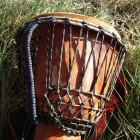There’s been a recent wave of discussion about an issue that hand drummers have faced (or not) since first beginning our journey with the drum: “cultural appropriation.” With the djembe having its roots in African culture, the question impinges on larger issues of race, identity, poverty, equality, respect.
I would outline my own core beliefs and stance on the matter as follows:
- I acknowledge that any person has a right to hold and express their own feelings and beliefs and standards about music, culture, or anything else.
- I hold and express the same right.
- These rights deserve respect regardless of how we might differ and disagree about the issues we discuss.
- Our choices and behavior should not be condemned if they cause no harm; conversely, we should take responsibility if our actions do cause harm.
- Music, as music, has no ownership, boundaries, or natural limits.
In my published collections of African drum rhythms, I have steered for the middle path incorporating both acknowledge and respect for tradtion, and freedom of new creative expression. In Roots Jam 2 (2002) I write:
This marriage of traditional pattern and creative freedom is the essence of my philosophy in Roots Jam (1 and 2), as reflected in the title. In both collections I have tried to be thorough and accurate in my research and transcription of traditional rhythms. I also recognize the inevitable mutation worked by the various translations along the way, as a pattern migrates from the cultural time and place it calls home. To memory’s lapses are added creative patches; the ear plays tricks and the recorder’s pencil errs. When we end up, in North America in 2002, with a dozen “traditional” arrangements of “Kuku,” how can we say which one is “authentic”? (“Tradition and Improvisation”)
The issue doesn’t go away—not in the eighteen years since writing that, or in the 800 years since the beginning of the Mali Empire. In the latest iteration, Roots Jam 4 (2019), I express the same sentiment this way:
It has been twelve years since the publication of Roots Jam 3, and in that time I’ve learned new rhythms from a variety of sources. For Guinea rhythms these include my primary teachers Famoudou Konate, Mamady Keita and Alseny Michel Diallo; for Mali rhythms my teachers in Thailand, Michael Pluznick and Timothy Dabrowski; for Maui rhythms, Rickyshay Cruz, Rick Thomson, Baba Karuna, and Glen Lacy; for tabla rhythms, Damian Finegan and Kevin Randall; for batucada fusion rhythms, Christopher Maseev, Matt Wright, and Sam Miller; for Afro-Cuban rhythms, Bararumba, Nancy Issenman, Tim Lukyn, and Jose Sanchez; for Belize rhythms, Emmeth Young. I have also made use of written and audio sources noted in the reference list at the end of this book.
Where pertinent I credit specific variations to a given teacher or source; but my intention here is to collect, compile and arrange rhythms for understanding and further inspiration, more than as authoritative transcriptions. Even when “translating” directly to this notation form from written sources, I admit to possible errors and so cannot guarantee perfect transmission of another’s teaching.
The diaspora of African music by nature is fluid and flexible to new interpretation—as it was even within the old village cultures, or among the many ballet masters currently arranging traditional rhythms in new ways. The spirit of this collection remains that of the Jam: to inspire dance and creativity with the foundational help of time-tested, even archetypal patterns of percussion. In that vein, please feel free to explore and share these rhythms with others.
Celebrate these gifts in your heart.
When you do, they will naturally be circulated to others.
And you, in turn, will find renewed energy, purpose and commitment to fully living your adventure.
—Mayan Oracle, Adventurer’s Quest


